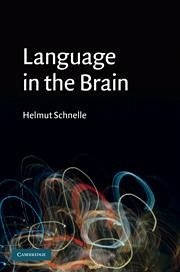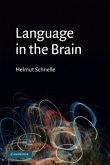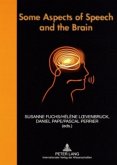Helmut Schnelle
Language in the Brain
Helmut Schnelle
Language in the Brain
- Gebundenes Buch
- Merkliste
- Auf die Merkliste
- Bewerten Bewerten
- Teilen
- Produkt teilen
- Produkterinnerung
- Produkterinnerung
A neurocognitive analysis of the form, use and meaning of language, bridging the gap between linguistic and neuroscientific studies.
Andere Kunden interessierten sich auch für
![Language in the Brain Language in the Brain]() Helmut SchnelleLanguage in the Brain59,99 €
Helmut SchnelleLanguage in the Brain59,99 €![Brain Research in Language Brain Research in Language]() Zvia Breznitz (ed.)Brain Research in Language110,99 €
Zvia Breznitz (ed.)Brain Research in Language110,99 €![Multilingualism in the Brain Multilingualism in the Brain]() Jasmin MohrMultilingualism in the Brain32,99 €
Jasmin MohrMultilingualism in the Brain32,99 €![Some Aspects of Speech and the Brain Some Aspects of Speech and the Brain]() Some Aspects of Speech and the Brain109,85 €
Some Aspects of Speech and the Brain109,85 €![Language Talent and Brain Activity Language Talent and Brain Activity]() Grzegorz Dogil / Susanne Maria Reiterer (ed.)Language Talent and Brain Activity129,95 €
Grzegorz Dogil / Susanne Maria Reiterer (ed.)Language Talent and Brain Activity129,95 €![Neurogenic Language Disorders in Children Neurogenic Language Disorders in Children]() Franco FabbroNeurogenic Language Disorders in Children204,99 €
Franco FabbroNeurogenic Language Disorders in Children204,99 €![Phonetics in the Brain Phonetics in the Brain]() Pelle SöderströmPhonetics in the Brain74,99 €
Pelle SöderströmPhonetics in the Brain74,99 €-
-
-
A neurocognitive analysis of the form, use and meaning of language, bridging the gap between linguistic and neuroscientific studies.
Produktdetails
- Produktdetails
- Verlag: Cambridge University Press
- Seitenzahl: 246
- Erscheinungstermin: 20. Mai 2010
- Englisch
- Abmessung: 235mm x 157mm x 18mm
- Gewicht: 514g
- ISBN-13: 9780521515498
- ISBN-10: 0521515491
- Artikelnr.: 29337398
- Verlag: Cambridge University Press
- Seitenzahl: 246
- Erscheinungstermin: 20. Mai 2010
- Englisch
- Abmessung: 235mm x 157mm x 18mm
- Gewicht: 514g
- ISBN-13: 9780521515498
- ISBN-10: 0521515491
- Artikelnr.: 29337398
Helmut Schnelle graduated in 1957 with a degree in Physics. His postgraduate studies between 1958 and 1962 included cybernetics, linguistics, and philosophy, leading to the first doctorate in philosophy on Leibniz' Arte Combinatoria. In 1967 he achieved a second doctorate (Dr. phil. habil.) based on the book manuscript 'Prolegomena for Formalization of Levels of Linguistics' and became Full Professor of Linguistics in Berlin. He has participated in US-supported research in theoretical and computational linguistics and in machine translation, including methodological discussions of linguistics at Hebrew University, research at the linguistic department of MIT and a study with Columbia University transforming east and west-European Yiddish language dialects into computer data. He has served as an academic consultant for IBM Germany in a project developing programs for practical uses of language. He is member of Academia Europea (London), Honorary Member of the Cercle Linguistique de Prague and in 2000 became Honorary doctorate at Bielefeld University, Germany. He was editor of the journal Theoretical Linguistics between 1974 and 2000. Helmut Schnelle also organised the first conference about language and the brain, on the occasion of awarding the honorary doctorate to Roman Jakobson and has since organized a 'Mind/Brain' conference in Paris. He is now continuing work with the Ruhr Universität Bochum, focusing on studying language in the brain and its organization of neural networks.
Part I. Introducing Cognitive Neuroscience to Linguists: 1. The brain in
functional perspective; 2. Organization in complex organisms; 3. Neural
perspectives of semantics: examples of seeing, acting, memorizing,
meaningful understanding, feeling, and thought; 4. Combination and
integration of intelligent thought and feeling; Part II. Introducing
Linguistics to Scientists: 5. Introducing formal grammar; 6. Grammar as
life; 7. Integrating language organization in mind and brain - the world of
thinking and knowing, liking or hating other people's mind/brain/bodies; 8.
Dynamic language organization in stages of complexity.
functional perspective; 2. Organization in complex organisms; 3. Neural
perspectives of semantics: examples of seeing, acting, memorizing,
meaningful understanding, feeling, and thought; 4. Combination and
integration of intelligent thought and feeling; Part II. Introducing
Linguistics to Scientists: 5. Introducing formal grammar; 6. Grammar as
life; 7. Integrating language organization in mind and brain - the world of
thinking and knowing, liking or hating other people's mind/brain/bodies; 8.
Dynamic language organization in stages of complexity.
Part I. Introducing Cognitive Neuroscience to Linguists: 1. The brain in functional perspective; 2. Organization in complex organisms; 3. Neural perspectives of semantics: examples of seeing, acting, memorizing, meaningful understanding, feeling, and thought; 4. Combination and integration of intelligent thought and feeling; Part II. Introducing Linguistics to Scientists: 5. Introducing formal grammar; 6. Grammar as life; 7. Integrating language organization in mind and brain - the world of thinking and knowing, liking or hating other people's mind/brain/bodies; 8. Dynamic language organization in stages of complexity.
Part I. Introducing Cognitive Neuroscience to Linguists: 1. The brain in
functional perspective; 2. Organization in complex organisms; 3. Neural
perspectives of semantics: examples of seeing, acting, memorizing,
meaningful understanding, feeling, and thought; 4. Combination and
integration of intelligent thought and feeling; Part II. Introducing
Linguistics to Scientists: 5. Introducing formal grammar; 6. Grammar as
life; 7. Integrating language organization in mind and brain - the world of
thinking and knowing, liking or hating other people's mind/brain/bodies; 8.
Dynamic language organization in stages of complexity.
functional perspective; 2. Organization in complex organisms; 3. Neural
perspectives of semantics: examples of seeing, acting, memorizing,
meaningful understanding, feeling, and thought; 4. Combination and
integration of intelligent thought and feeling; Part II. Introducing
Linguistics to Scientists: 5. Introducing formal grammar; 6. Grammar as
life; 7. Integrating language organization in mind and brain - the world of
thinking and knowing, liking or hating other people's mind/brain/bodies; 8.
Dynamic language organization in stages of complexity.
Part I. Introducing Cognitive Neuroscience to Linguists: 1. The brain in functional perspective; 2. Organization in complex organisms; 3. Neural perspectives of semantics: examples of seeing, acting, memorizing, meaningful understanding, feeling, and thought; 4. Combination and integration of intelligent thought and feeling; Part II. Introducing Linguistics to Scientists: 5. Introducing formal grammar; 6. Grammar as life; 7. Integrating language organization in mind and brain - the world of thinking and knowing, liking or hating other people's mind/brain/bodies; 8. Dynamic language organization in stages of complexity.








